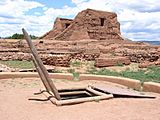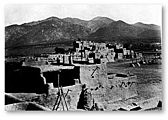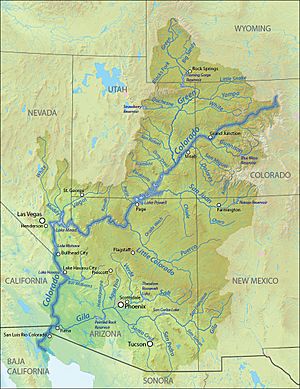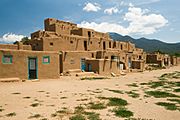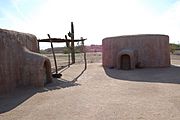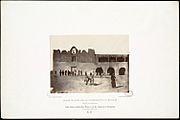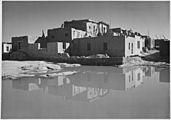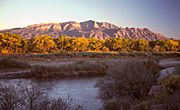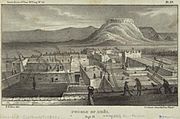Pueblo IV Period facts for kids


The Pueblo IV Period (from about 1350 AD to 1600 AD) was an important time for the ancient pueblo people. They lived in the American Southwest. Before this period, during the Pueblo III Period, many people left their homes in Colorado and Utah. They moved south to the Pecos River and Rio Grande valleys. This caused a big increase in the number of people living in those areas.
The Pueblo IV Period is also sometimes called the "Regressive Pueblo Period." Or, for the people in Colorado and Utah, it's called the "Post Pueblo Period." It came after the Pueblo III Period and before the current Pueblo V Era.
Contents
Homes and Buildings
Pueblo villages in Arizona and New Mexico were very large. They had multi-story buildings with up to a thousand rooms all connected. The villages in New Mexico were usually bigger than those in the western areas. They often had large open spaces called plazas. These plazas featured long, rectangular kivas, which were special rooms used for ceremonies.
Where People Lived
A lot of people moved from Colorado and Utah at the end of the Pueblo III Period. This led to many new people settling in the Rio Grande and Little Colorado River valleys. Within Arizona and New Mexico, people moved from smaller sites to live in bigger pueblos. During the Pueblo IV Period, Puebloan lands also included the White Mountains, Verde Valley, Anderson Mesa, and Pecos areas.
- Rio Grande valley: When the Spanish arrived around 1540, they found many Puebloan people living in the Rio Grande Valley. This included areas like Acoma Pueblo and Zuni Pueblo.
- Bandelier area: Pueblos in the Bandelier area grew a lot after 1300. More buildings were built, the population increased, and life got better. Pottery found there looked just like pottery from Mesa Verde National Park. This suggests some new residents came from Mesa Verde.
- Abandoned places: Many early Pueblo IV sites were left empty by the 1400s. These included places in the White Mountains, Verde Valley, and Anderson Mesa. Villages in the Petrified Forest were mostly abandoned by the late 1500s. Even though people left, the land was still used for its resources and for travel.
-
Taos Pueblo in 1880
Arrival of the Spanish
Life in the Rio Grande valley improved at the start of the Pueblo IV Period. However, this changed in the 1500s with the Spanish colonization of the Americas. Spanish rule spread north into New Mexico. Don Juan de Oñate was the Spanish governor of New Spain's New Mexico province. In 1598, he led 400 soldiers and farmers to set up new settlements in the Rio Grande valley.
Culture and Beliefs
- The people: In the 1300s, people living in Frijoles Canyon, near Bandelier National Monument, had black hair and reddish-brown skin. They were not very tall. Men were about 5 feet 4 inches, and women were about 5 feet tall. Most couples had a few children. Domesticated dogs were often part of their families.
- Religion: By 1300, the Ancient Pueblo People started using Kachina religious rituals. This helped bring together different groups of people who moved into the area. It also helped unite those living in the large pueblos. This culture encouraged people to work together, share food, and perform religious ceremonies. These ceremonies included rituals for making rain. Kachina images appeared in paintings inside kivas, and on rocks as pictographs and petroglyphs. The Kachina religion became very important for the modern Zuni and Hopi people.
Farming and Food
Pueblo sites were built near reliable water sources. These sources were often used to water their farm fields. Gardens were made in terraces and in stone-outlined "waffle gardens" close to the pueblos. After harvesting, maize (corn) was ground using special stones called manos and metates. The discovery of griddle stones suggests they made thin, paper-like cornbread.
People also hunted small animals and birds. They gathered wild plants that grew during different seasons to add to their diet:
- Spring: They gathered beeweed and mustard greens.
- Summer: They found chokecherries, currants, gooseberries, raspberries, and yucca fruit.
- Fall: They collected seeds, nuts, juniper berries, and prickly pears.
Pottery Styles
During this period, smooth pottery replaced the bumpy, corrugated pottery from the Pueblo II and III Periods. Pottery started to be red, yellow, orange, or polychrome (many colors). This was different from the black-on-white pottery of earlier times. The pottery was often made in large amounts and was of high quality. In the western Ancestral Pueblo areas, pottery often featured Kachina figures and symbols. Glazed pots also appeared. These were made by firing mineral paints on the pottery at very high temperatures. Artisans in the Petrified Forest made beautiful Glaze-on-Red polychrome pottery.
Other Important Items
Some new items that appeared during this time included small, triangular projectile points (arrowheads) and piki stones, which were used for making a type of bread.
Main Cultural Groups
The main cultural groups living during this period were:
- Ancestral Puebloans: Found in southern Utah, southern Colorado, northern Arizona, and northern and central New Mexico.
- Hohokam: Lived in southern Arizona.
- Mogollon: Found in southeastern Arizona, southern New Mexico, and northern Mexico.
- Patayan: Lived in western Arizona, California, and Baja California.
Notable Pueblo IV Sites
Here are some important Pueblo IV sites:
Gallery
-
Ruins at Bandelier National Monument
-
Pueblo Grande, Arizona
-
Acoma Pueblo, photographed by Ansel Adams
-
Sandia Mountains, a sacred place for the Sandia Pueblo people


